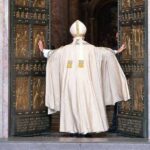About the Jubilee Year 2025:
It was announced by Pope John Paul II at the end of the Great Jubilee (December 24, 1999 to January 6, 2001), that there will be a jubilee year every 25 years. Therefore, the year 2025 will be a Jubilee Year, beginning on December 24, 2024 and ending on January 6, 2026.
A Jubilee Year is a special year of grace, in which the Catholic Church offers the faithful the possibility of asking for a plenary indulgence (the remission of sins for themselves or for deceased relatives). A bit different from the secular calendar, the year starts on December 24.

The most well-known rite that starts the Jubilee Year is the opening of the Holy Door in Saint Peter’s Basilica.
This is followed on successive days by opening the Holy Doors on the other 3 Major Basilicas: Saint John Lateran, Saint Paul Outside the Walls and Saint Mary Major.
These doors remain open until the end of the Jubilee, when they are once again walled up.
If you plan to travel to Rome, The Pilgrims’ Center – Info Point is the main reference place for pilgrims and tourists who want to stay updated about the upcoming Jubilee Year 2025. They are located 7 Via della Conciliazione, right near the Vatican.
The Pilgrims’ Center people can find out the main ways of participating in pilgrimages to the Holy Door and learn about preparatory events for the Jubilee, as well as find out about volunteering. It is also a distribution point for information leaflets and flyers containing basic information about the Jubilee and the various pilgrim routes round Rome such as the Seven Churches Pilgrimage, the pilgrim route of the Female Doctors of the Church and the Patrons of Europe and the Churches of Europe itinerary. A team of staff will be always available at the Info Point.
You can find out more from the official website of the 2025 Jubilee Year here.
There will be other Holy Doors for the 2025 Jubilee Year in addition to the ones in Rome.
For example, the Holy Door at the Basilica of the National Shrine of the Immaculate Conception in Washington, D.C. In preparation for the 2025 Jubilee Year the Holy Door was sealed and blessed on the First Sunday of Advent (Dec. 3, 2023) at noon by Archbishop Timothy P. Broglio. There will undoubtedly be other Holy Doors in churches and shrines throughout the world for those who cannot travel to Rome…we just don’t have all the locations at this time.
The Jubilee Year 2025 Pilgrims Center in Rome:
As the Jubilee Year approaches the Pilgrims’ Center will increasingly become a welcome point for those arriving in Rome, as well as the hub for organizing bookings and access requests. It will also distribute the ‘testimonium’ ……..a certificate that Saint Peter’s Basilica issues on request, as certification of the pilgrimage to all those who have traveled at least 100 km (62 miles) on foot or 200 km (124 miles) by bicycle to Rome. This journey must be verifiable by the stamps placed on the pilgrim’s credential for pilgrims. Given its position on the Via della Conciliazione (very close to the Vatican, and one of our favorite streets) it will also serve as a reference point for all eventualities for both pilgrims and volunteers.

